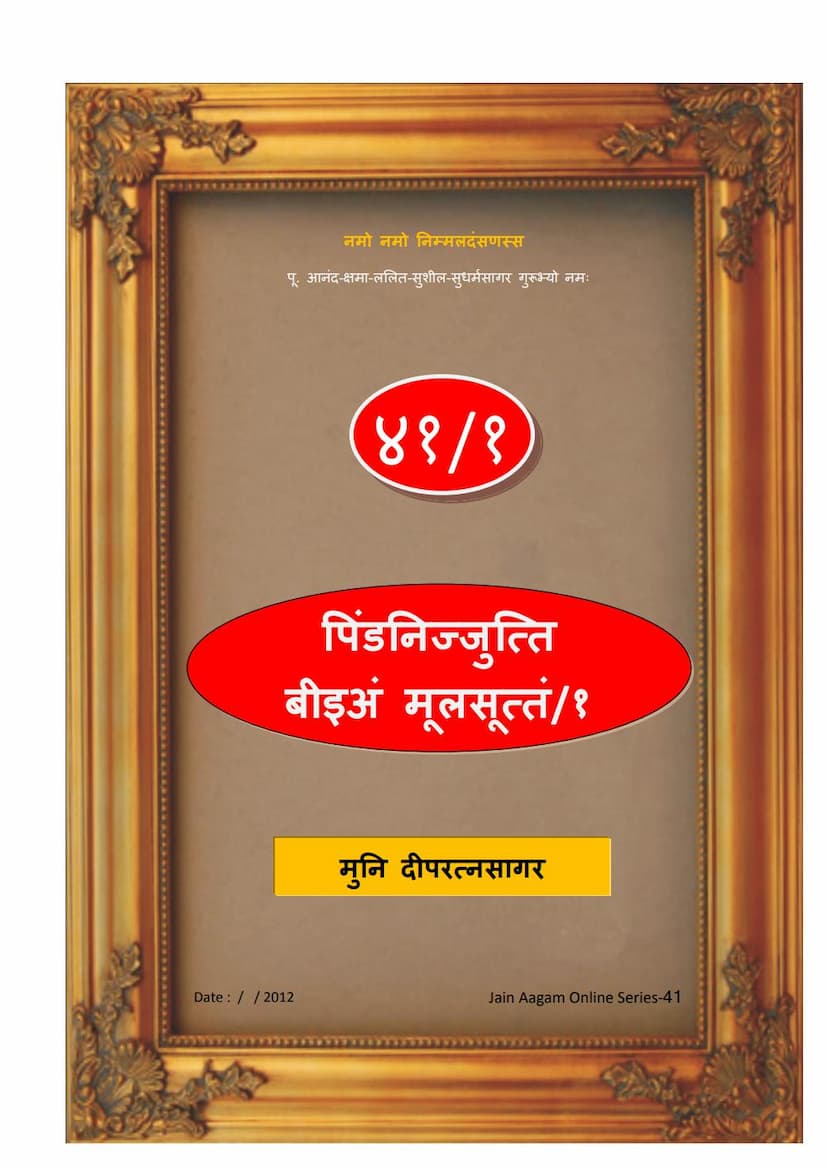Agam 41 Pindnijutti Beiyam Mulsuttam Mulam PDF File
Added to library: September 1, 2025

Summary
This document is a Jain text titled "Agam 41 Pindnijutti Beiyam Mulsuttam Mulam PDF File" by Dipratnasagar and Deepratnasagar. The text is a commentary or explanation of the "Pindnijutti," which is itself a commentary on a foundational Jain scripture (Mul Sutra).
Here's a breakdown of the content based on the provided pages:
Overall Purpose: The "Pindnijutti" appears to be a detailed exposition of principles related to the conduct and practices of Jain ascetics (monks and nuns), particularly concerning their daily activities, food, possessions, and ethical conduct. It seems to elaborate on various aspects of the Jain path to liberation (moksha) by providing guidelines on what is permissible and what is not.
Key Themes and Concepts:
- Pinda (पिंड): The title itself suggests the central theme is "Pinda." In Jainism, "Pinda" can refer to several things, including a collection or lump, a spiritual practice, or even the body. Given the context of monastic conduct, it likely refers to the collection of offerings, food, or other necessities, and the principles governing their acquisition and use.
- Nijjutti (निज्जुत्ति): This term signifies a commentary or explanation, indicating that the text is an in-depth analysis of the core principles.
- Mula Sutra (मूलसूत्तं): This refers to the original, foundational scriptures of Jainism, implying that the Pindnijutti is an interpretive work that clarifies these foundational teachings.
- Eightfold Classification (अट्ठविहा पिंडनिज्जुत्ति): Page 3 states that "Pindnijutti" is of eight types: Uggama (उगम), Utpaadana (उप्पायण), Esana (एसणा), Samyojana (संजोयणा), Pramana (पमाणे), Ingala (इंगाल), Dhum (धूम), and Karana (कारण). The text then proceeds to explain these categories.
- Classifications of Pinda: The text delves into different ways of classifying "Pinda" based on:
- Names (नाम): Symbolic or conceptual representations.
- Placement/Establishment (स्थापना): Physical representations or symbols.
- Substance (द्रव्य): The actual physical materials.
- Place (क्षेत्र): The location.
- Time (काल): The temporal aspect.
- Mode/State (भाव): The qualitative aspect.
- Types of Substances (द्रव्य): A significant portion of the text is dedicated to classifying substances into:
- Sachitta (सचित्त): Living substances (e.g., plants with life force).
- Misra (मिश्र): Mixed substances (e.g., fruits mixed with substances that make them impure).
- Achitta (अचित्त): Non-living substances (e.g., water, minerals).
- The text further subdivides these, detailing specific examples like earth (पृथ्वी), water (आउक्काओ), fire (तेऊ), air (वाऊ), plants (वनस्पति), and different types of beings (two-sensed, three-sensed, four-sensed, five-sensed).
- Usage and Purity (प्रयोजनं): The text discusses the conditions under which these substances are considered permissible or impermissible for ascetics. This includes concepts like:
- Impurities (दोष): Various types of contaminations that can render something unsuitable.
- Purpose of Use (प्रयोजनं): The specific reasons for using a substance.
- Cleanliness and washing (धोवणं): Rules regarding the cleaning of items.
- Forbidden actions (अनादेशा, अनायदेशा): Actions that are prohibited.
- Ethical Conduct and Behavior: The text elaborates on various ethical considerations:
- Taking the vow (अभिग्गह): Commitment to certain principles.
- Discrimination in actions (भावण): Understanding the nuances of right and wrong actions.
- Karma (कर्म): The concept of actions and their consequences, distinguishing between auspicious (प्रशस्त) and inauspicious (अपशस्त) karma.
- Protection from negative karma: Guidelines on how to avoid accumulating bad karma.
- Right faith, knowledge, and conduct (दर्शन-ज्ञान-चारित्र): The three jewels of Jainism.
- Purity of intention (भाव): The importance of inner state.
- Specific Prohibitions and Guidelines: The text provides detailed rules and examples for various scenarios, including:
- Aahakarma (आहाकम्म): Food that is specially prepared or offered, and the rules surrounding it.
- Uddeshiya (उद्देसिय): Food specifically set aside or designated for someone.
- Pooikarma (पूईकम्म): Impure or decayed substances.
- Misraja (मीसजा): Mixed substances.
- Paahudiya (पाहुड़िया): Gifts or offerings.
- Payaar (पाओअर): Things obtained through purchase.
- Kiyat (कीय): Things bought.
- Paamichchya (पामिच्चे): Things obtained through begging.
- Adhyoyatar (अज्झोयर): Things obtained through improper means.
- Detailed descriptions of prohibited actions: The text uses numerous examples and scenarios to illustrate violations of monastic rules.
- The Importance of Knowledge and Discrimination: Throughout the text, there is a strong emphasis on the need for ascetics to have clear knowledge and discernment to correctly identify and avoid impure or forbidden substances and actions.
Structure of the Text: The document seems to follow a structured approach, likely dedicating chapters or sections to each of the eight types of Pindnijutti mentioned. The inclusion of "गाहा" (Gaha), which are verses or couplets, suggests that the text is likely written in a poetic or metrical style, common in ancient Indian religious literature.
In essence, this text is a comprehensive manual for Jain ascetics, providing rigorous guidelines on purity, ethical conduct, and the proper way to sustain oneself while striving for spiritual liberation. It meticulously details the classifications of various substances and actions, emphasizing the importance of knowledge, vigilance, and adherence to principles to avoid karmic entanglement.